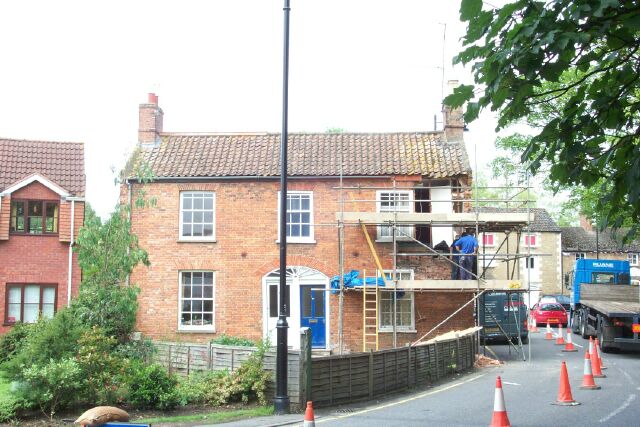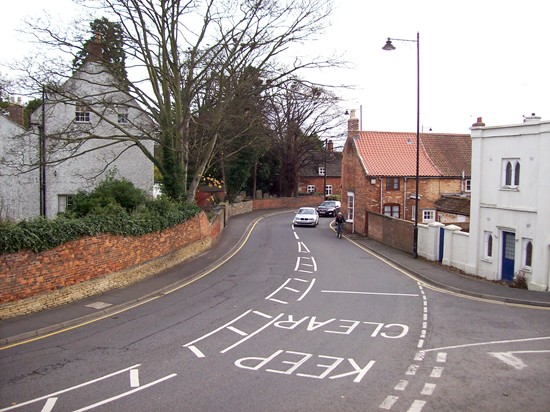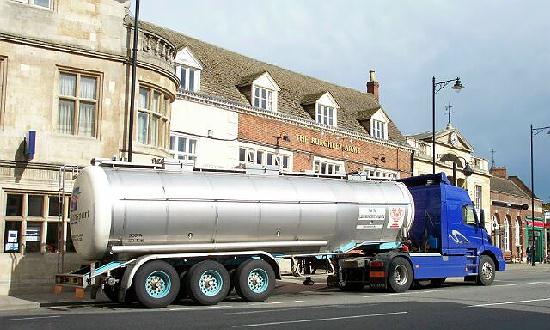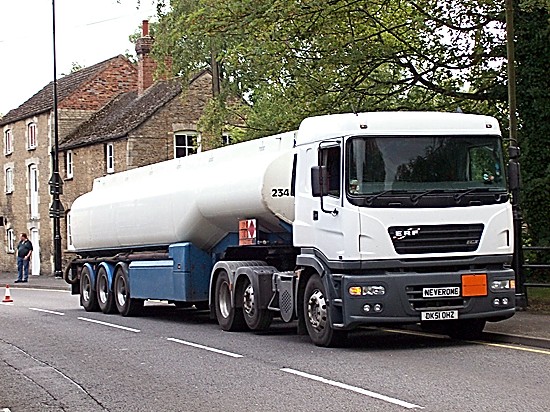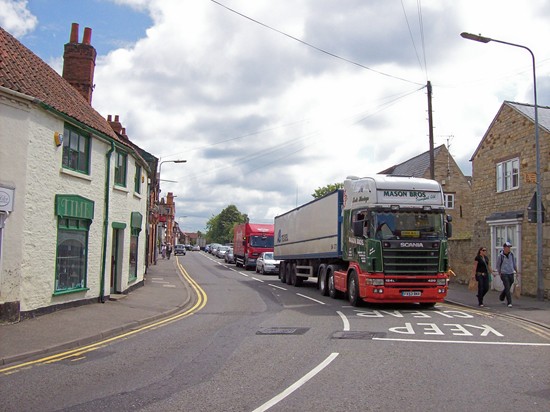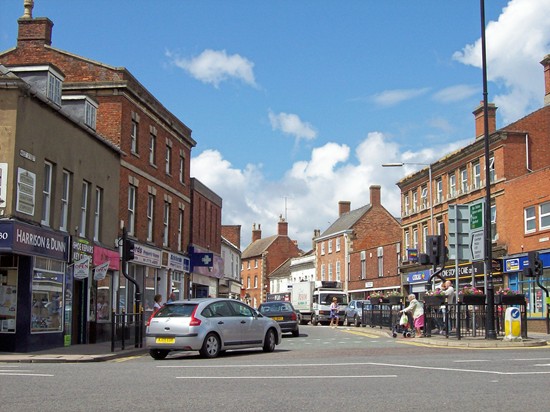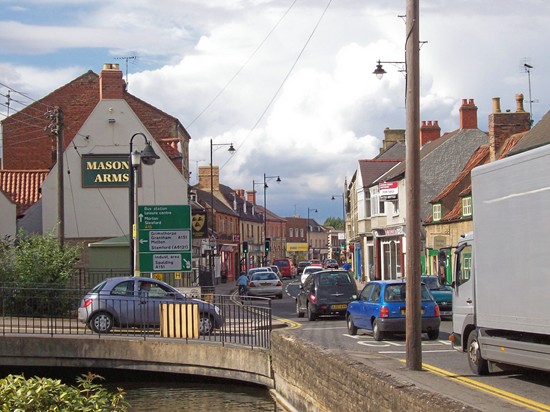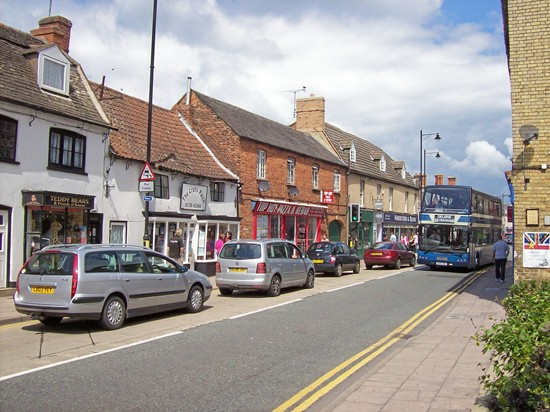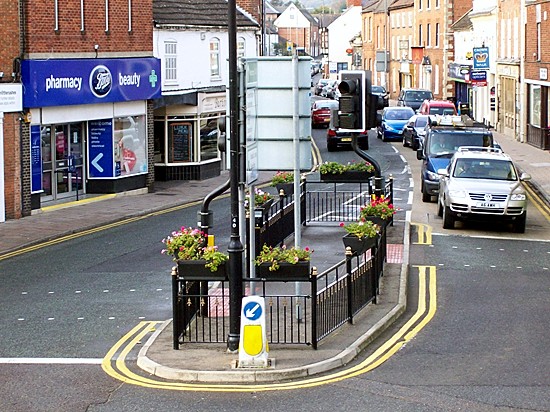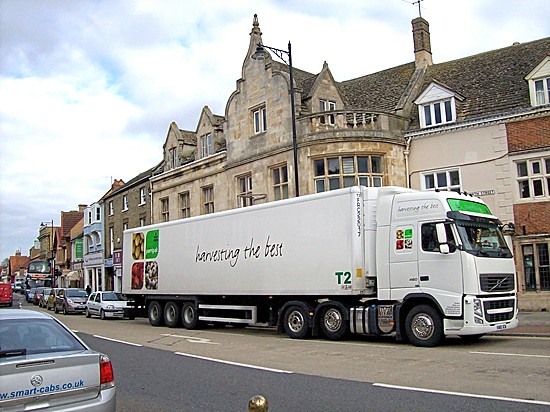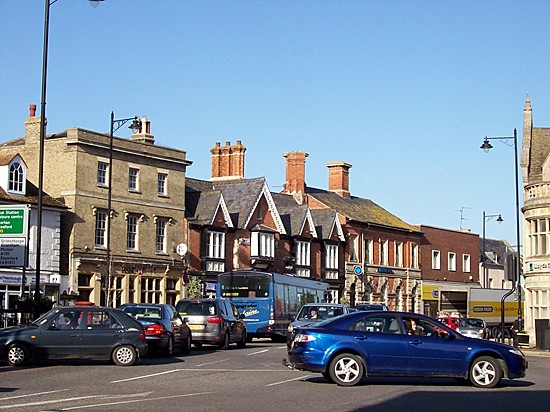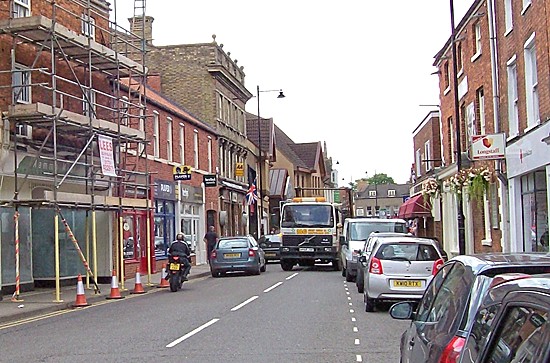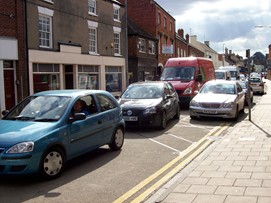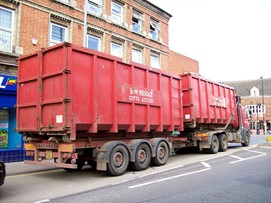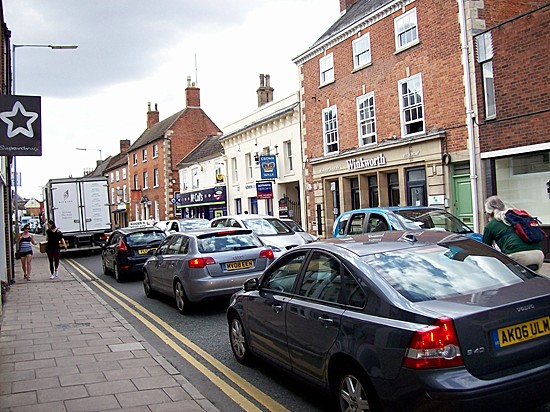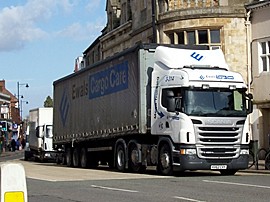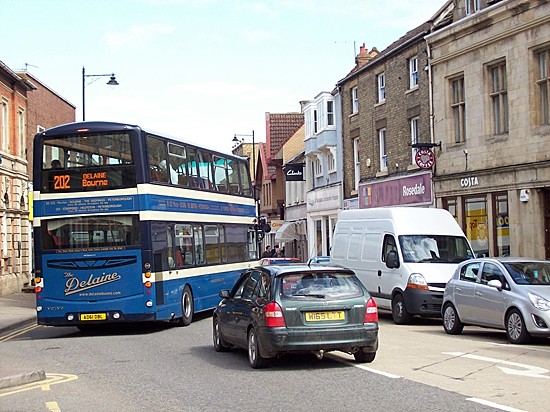|
Roads
and traffic

A beleaguered
shopper on a weekday morning waits for the chance to cross
Two main roads cross in the town centre at Bourne and
although there is a south-west relief road for the A151 from east to west,
there is no bypass for the A15 from north to south with the result that an
increasing amount of heavy traffic uses this route.
The town centre was the market place in years past, the hub of the community, scene of sheep fairs, processions, regimental marches and various gatherings, not least the celebrations to mark Queen Victoria's Diamond Jubilee in 1897 and the proclamation of King George V from the steps of the Town Hall in 1910. Today, it is difficult to cross the road at this point and traffic fumes are a health hazard.
The building and maintenance of our roads during the 19th century was the
responsibility of the Vestry Meeting and it was not until 1873 that
surveyors of highways were employed to ensure that they were kept in good
order. The first were John Gibson and Charles Eldred who were appointed on
Monday 24th March. The clerk, Mr John Bell, told the meeting: "So great a
length of road now has to be maintained by the parish that it is desirable
for efficient and paid surveyors to be appointed and they will be
responsible for the roads being kept in a proper state of repair which is
not the case at present." It was a casual approach to a mounting problem
because their work was part time, both businessmen busy with their own
affairs, Mr Gibson being a hay and corn merchant and maltster of West
Street and Mr Eldred a brick and tile manufacturer of North Road. The
Local Government Act of 1894 regularised this work by passing the
responsibility to the newly-formed local authorities which appointed
qualified highway surveyors working full time, so recognising the growth
development of the country's road system. The building and maintenance of
highways is now carried out by Lincolnshire County Council, a costly and
highly efficient operation financed by a multi-million pound budget.
Buses and coaches were once a most popular form of travel and one that rivalled the railways. But the increasing number of car owners during the second half of the 20th century was a major factor in the closure of local railway lines and the curtailment of many bus routes. The coach companies were flourishing in the early years of the century and the green buses of the Lincolnshire Road Car Company linked Bourne with the neighbouring towns and villages while the history of Delaine Coaches Limited, from 1890 to the present day, gives a specifically local example of how public passenger transport not only developed but also survived the changes and is now one of the most successful in Britain today.
Increasing traffic flows have played a major part in the expansion of Bourne and brought it nearer urbanisation. In 1970, a sample traffic census revealed that in the peak hour between 8 a m and 9 a m on a Thursday market day, the number of vehicles entering the town by the four main roads was 733 while during the same hour, 642 vehicles left. But despite this motorised activity, Bourne was still considered to be a rural area and in January 1972, a fox appeared in the Market Place at 11.30 a m and was caught in the bus waiting room beneath the Town Hall, a reminder that the countryside was still not far away. Nevertheless, this once quiet country community was becoming busier and as the weekly street market was then held in the town centre, which was also a stopping place for buses, some regulation was needed and
on Monday 11th June 1973, the first traffic lights were installed at a
cost of £10,000.

The town centre soon after the traffic lights were installed in 1973
They did not meet with universal approval
and within a few days many people had voiced misgivings over the safety of
shoppers. Bourne Urban District Council hastily arranged a meeting with
the engineers and told them that changes must be made immediately because
of complaints that there were no pedestrian crossing controls and this
presented a very real danger, especially for children and old people, at
what was becoming a very busy intersection in the town centre. After the
meeting, the chairman, Councillor Percy Wilson, was most emphatic about
the hazards involved. "Three-fifths of the children from Bourne
Primary School have to use the crossings and they do not know where to
cross", he said. "A traffic warden and local police have to help
them. If people try to cross in West Street, they are likely to encounter
traffic coming from South Street. We left the engineers in no doubt that
their installation was not what we were led to believe. We are quite
dissatisfied with the arrangements relating to the traffic lights and the
pedestrian crossings are lethal. They are death traps. The flow of traffic
must take second place to the safety of our people, especially the young
and the old. Safeguards for them are uppermost in our minds."
Alterations
to the system were eventually made but there was still
criticism that the traffic lights in the town centre have outlived their
usefulness and should have been replaced by a mini roundabout which would
give a right of way to all traffic from the right. Such systems are now
operating in all major towns and cities in Britain, and even in Bourne at
other less sensitive spots such as West Street at the junction with Exeter
Street, and in North Street at the junction with St Gilbert's Road and Meadowgate. It is believed that a similar arrangement in the town centre
would ease vehicle flows and prevent the traffic jams that have become a
common occurrence in recent years, and that this point has been amply
demonstrated by the many failures of the lights in recent years when
traffic flows continued smoothly and with little delay.
| However, frequent breakdowns in the
system persuaded Lincolnshire County Council that the traffic
lights were in need of replacement and the work was carried out
during the summer of 2004. Although this involved many diversions
and long delays for vehicles and frustration for shoppers, the
project was completed on schedule within ten weeks at a cost of
£170,000 and the system became effective from Monday 28th September.
The enclosed refuge in the centre of West Street,
known locally as "the pig pen", that enabled pedestrians wait until
the road was clear, was retained but widened and enclosed with
ornamental ironwork and the lights were synchronised to provide
additional safety for anyone crossing. |
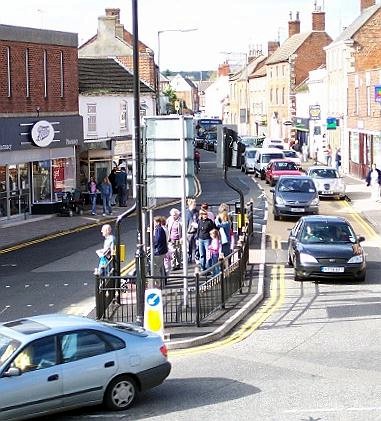 |
Pedestrian crossing points around the intersection were fitted with
rotating tactile cones to allow the visually-impaired know when it is safe
to cross while other improvements included high friction anti-skid
surfacing on the approaches to the lights. Kevin Brumfield, the county's
area highways manager, said that despite periods of heavy rain, the work
had gone very smoothly and had been completed two weeks earlier than
anticipated. "It is designed to make the area safer for pedestrians as
well and improving the operation of the lights and we now have proper
crossing points for the elderly and disabled", he said.
There were also attempts during the 1970s
to move the market off the streets because of the dangers being created by
stalls erected alongside the pavements in North Street and West Street, so
narrowing the space available for passing traffic although it was to be
several more years before this was to become a reality. But it was obvious
at this time that buses could not continue to use the Market Place as
their terminus and in 1974, a new bus station was opened in North Street.
Increasing vehicle movement through the town also threatened the Ostler memorial drinking fountain that had been standing in the market place for 100 years because it was creating a danger to passing vehicles and in 1960 it was moved to the seclusion of the town cemetery. Since then, the number of vehicles passing through Bourne has increased annually and the current traffic light system often appears to be totally inadequate, causing long tailbacks in all directions and annoying delays for drivers. On those occasions when the lights have failed and the roundabout system of giving way to traffic on the right was implemented, there were calls for this method to be introduced permanently but it was not given serious consideration by the county highways authority.
A bypass would be the obvious answer and in 1991, Lincolnshire County Council
did announce that work was due to start on a Bourne bypass in April 1994 with a
completion date of October 1995 but the scheme was shelved when the government
drastically pruned its road building programme and with the cost of new
carriageway estimated at £1 million per mile, Bourne is a low priority and it is
unlikely to be reinstated in the foreseeable future.
|
One of the familiar Delaine double-decker buses
passing the sharp double bend in South Street on a routine run between
Bourne and Peterborough. This family run company is one of the main users
of the bus station in North Street. |
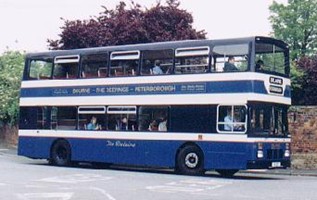 |
A double bend in South Street, the main road leading out of Bourne on the A15, is acknowledged as the major accident black spot for the town and yet has commanded little attention from the highways authorities over the years, a responsibility that now rests with Lincolnshire County Council. This spot, overlooked by the Abbey Church, was the scene of yet another bad accident on Wednesday 12th June 2002 when
a 38-tonne articulated refuse lorry crashed into a roadside cottage, No 31 South Street, demolishing part of the outside wall and sending rubble crashing down into the street below where children had been walking past just moments earlier.
There have been many other accidents here over the years, one of the worst in 1989 when a Royal Mail lorry ploughed into the same cottage, which is a Grade II listed building and stands immediately on the bend, and five years ago a car suffered a similar fate. There have also been fatalities, the most recent in October 1998 when a van driver was killed on the corner as he drove into Bourne.
Those responsible for road safety in the Bourne area know that this double bend is one of the most dangerous in the county. An awareness of such accident blackspots began to develop early in the 20th century when the motor car was still a rare sight on the road and yet in 1909, the newly formed Lincolnshire Automobile Club supplied danger warning signs that were erected in Abbey Road. The double bend in South Street was known as Dr Gilpin's corner because the good doctor then lived and ran his practice from Brook Lodge, the former vicarage next to the church, and it began to cause some disquiet about the same time and yet the local authorities turned down a proposal to purchase land at this point with a view to widening the roadway in 1910.
However, there were several mishaps on the corner and early in 1917, danger signs were erected after a complaint by a local resident who was involved in an accident not with his car, but with his horse and cart. There were more collisions in subsequent years and in 1928, Kesteven County Council, then the highways authority, was asked to improve the road as a matter of urgency but as we all know, nothing was done. The problem was exacerbated by the railway that crossed the road a few yards further south and the traffic delays were compounded when the level crossing gates were shut to allow a train to pass. Although this added inconvenience disappeared when the Bourne to Spalding line closed in 1959, the situation has become far worse in the intervening years because of the massive increase in through traffic.
The local authorities missed a second chance to improve the road at this point
when a cottage attached to the smallholding No 35 South Street was demolished in January 1977. The location of the property was unfortunate because it stood on the west side and looked as though it was leaning forwards into the road at a most unsafe angle, creating a road hazard for the increasing traffic flows of the previous decades, and although scheduled as a Grade II building, it was pulled down in January 1977. This was the perfect chance to improve the highway at this point and remove a highly dangerous black spot and yet again, nothing was done. Instead, permission was given to build two new houses on the land that had been made vacant by the demolition although they were sited well back from the road.
But the double bend remains, a nightmare for motorists during the rush hour periods, especially in the evenings, when queues of traffic tail back as far as the grammar school and even further and each accident that occurs reminds us of another tragedy lurking just
around the corner. This is one of the worst stretches of urban road in Lincolnshire and is in dire need of improvement or replacement as a matter of urgency and yet the local authorities do nothing.
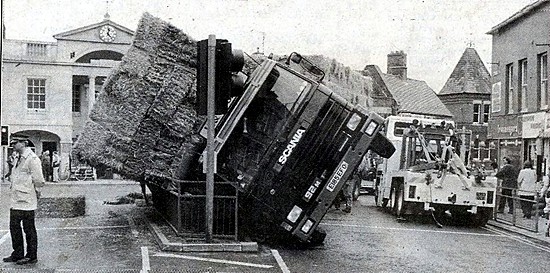
Never has the need to rid the town centre of its
heavy through traffic been better illustrated than by the events of 1993 when a huge lorry overturned on the pedestrian island at the
entrance to West Street.
The 20-tonne vehicle blocked the road for almost two hours at lunchtime on
Saturday 24th April, spilling its load of straw, and the emergency services
stood by because of fears that leaking diesel fuel could be ignited by the
electricity supply to the traffic lights which had been flattened by the impact.
Miraculously, the driver escaped injury and although this was a busy time in the
town, none of the many shoppers who were in the vicinity were hurt.
The accident highlighted the increasing danger from heavy traffic using the main
roads through Bourne, the A15 and the A6121, and renewed calls for a bypass.
Town councillor Peter Garner warned of the danger in an interview with the
Lincolnshire Free Press. "With all the shoppers about, we were lucky that no one
was killed", he said (April 27th). "We have got to get heavy traffic out of the
town centre as a matter of urgency."
Councillor Garner pointed out that work on the new Spalding bypass had then
started and the Market Deeping bypass then scheduled (both now completed) but
proposals by the highways authority, Lincolnshire County Council, for a relief
road east of Bourne "were faulty and showed a lack of detailed knowledge. A
western route, he said, would cope better with traffic from the A15 south as
well as the A151 from Colsterworth and the A6121 from Stamford. "With the
planned improvements to the A1, we are going to get more and more traffic from
those directions", he said.
In the event, it was to be another twelve years before a south-western bypass
was eventually opened, a new 1.5 mile stretch of single carriageway from South
Road to West Road built at a cost of £4 million by the developers as part of the
planning gain for the Elsea Park estate. This has relieved the town centre of
a great deal of traffic but there are still problems at busy periods when North
Street is at a standstill as both lanes are jammed with heavy vehicles and
although there has been much talk of a new north-south by pass for the A15,
there is little or no likelihood of it materialising in the foreseeable future
and this incident is therefore a stark reminder of what could happen until it
is.
|
FROM THE ARCHIVES |
|
We some time ago noticed the many improvements which
have been made in the Middle District of the Lincoln and Peterborough
road: we have pleasure in stating the removal of other impediments. At the
south entrance into the town of Bourne there was a very disagreeable turn
round by the vicarage; we find this will be nearly (if not wholly) removed
by an alteration which is now taking place: a considerable portion of the
garden there has been liberally conceded for the promotion of this object:
and further on, two tenements belonging to Mrs [Catherine] Digby have been
rased, making the approach to the town less circuitous and very much more
agreeable. - news report from the Stamford Mercury, Friday 23rd
December 1831. |
REVISED JULY 2014
See
also
Why Bourne will not get a bypass
The necessity of a bypass

Go to:
Main Index Villages
Index
|




